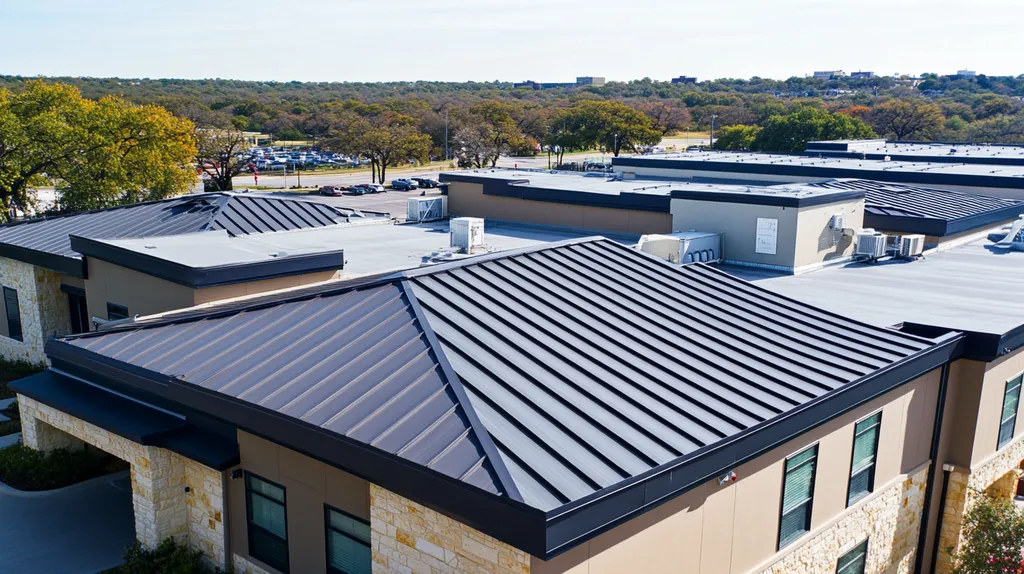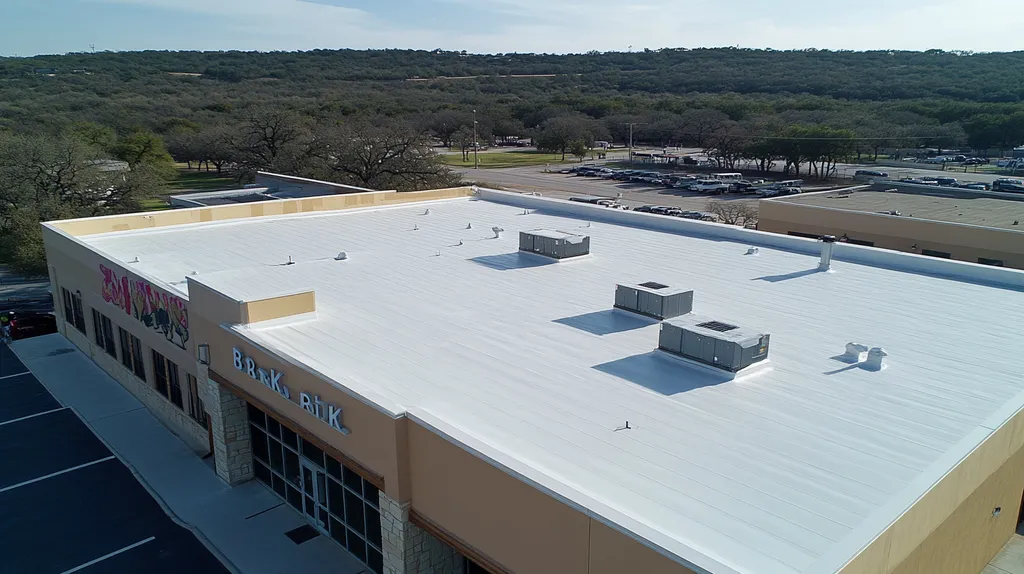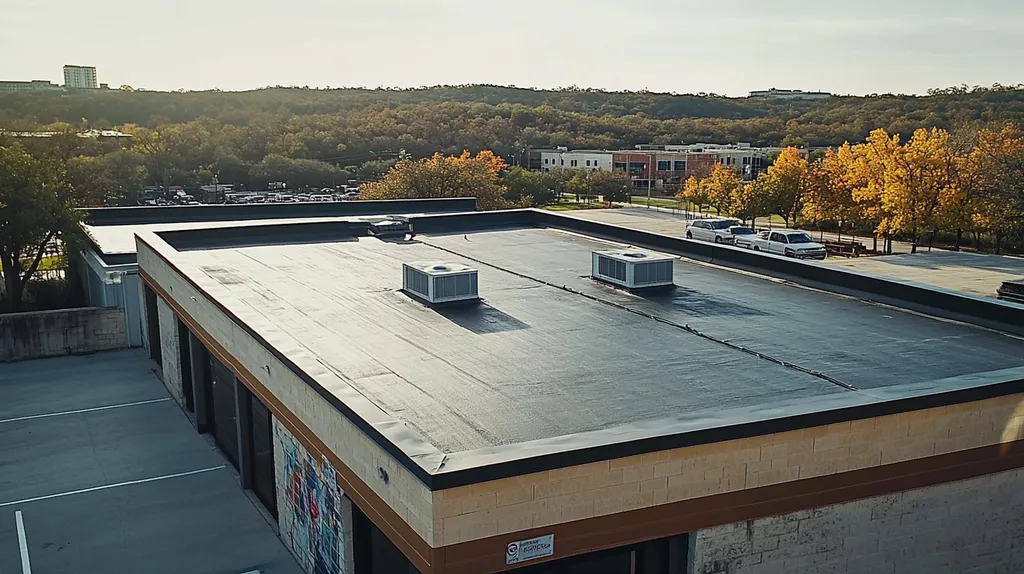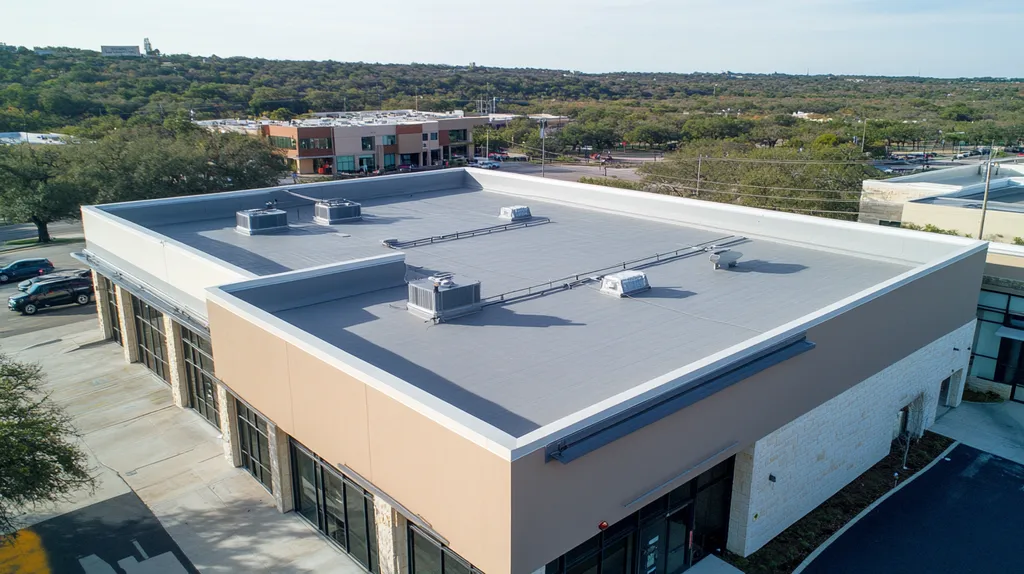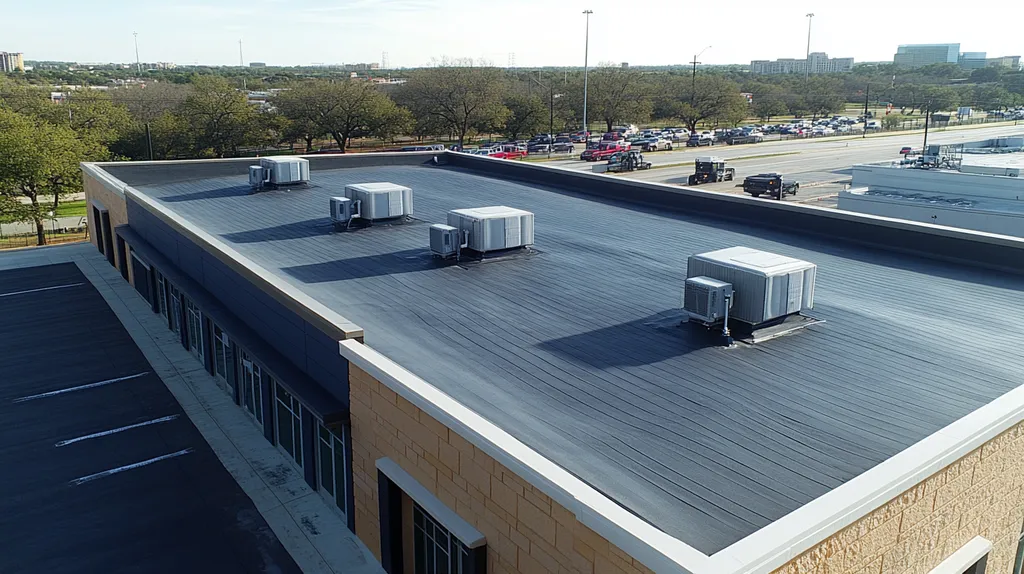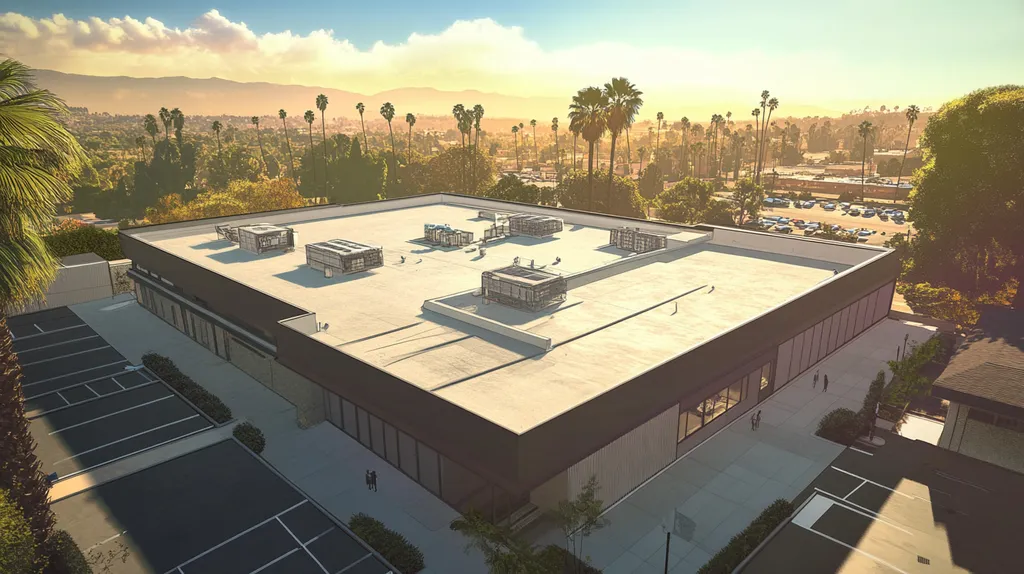Commercial building owners face mounting pressure as energy costs continue to rise, with inefficient roof systems accounting for up to 40% of heating and cooling losses in typical facilities.
The selection and implementation of energy-efficient roofing solutions has become critical for maintaining operational viability and meeting increasingly strict building performance standards.
This comprehensive guide provides facility managers with practical steps to evaluate, select, and maintain energy-efficient roof systems while navigating financial considerations, compliance requirements, and long-term sustainability goals.
SECTION 1: PERFORMANCE FACTORS
In the current energy-sensitive landscape, the efficiency of commercial roof systems significantly impacts overall building performance. Rising energy costs make it essential to prioritize effective thermal insulation and roof assembly strategies. In fact, a poorly insulated roof can inflate energy bills by as much as 30%. Recognizing and addressing these performance factors is key to reducing both expenses and environmental impact. This section delves into critical aspects such as thermal insulation, reflective qualities of roofing materials, and moisture control measures.
Assessing Thermal Insulation and Roof Assembly Efficiency
Thermal insulation serves as the backbone of energy efficiency in roofing systems. It directly influences heat retention and overall energy consumption. Investing in quality insulation can lead to substantial reductions in heating and cooling costs, often recouped in just a few years.
The efficiency of roof assemblies also plays a pivotal role. This encompasses the types of materials used and how they are constructed. Well-designed assemblies can enhance insulation performance, effectively minimizing heat transfer.
To maintain effective insulation, regular assessments are necessary. Factors like weathering and structural settling can degrade insulation over time.
Key Action Items
Evaluating Reflective and Emissive Properties of Roofing Materials
The reflective and emissive characteristics of roofing materials are critical in controlling building temperatures. High reflectivity can deflect solar energy, which significantly reduces cooling costs in the warmer months. Some roofing materials boast the ability to reflect up to 90% of sunlight.
Emissivity—how well a material emits absorbed heat—supports the benefits of reflectivity. Roofing with high emissivity can effectively release heat overnight when temperatures drop. Selecting the right mix of reflective and emissive materials enhances energy efficiency even further.
Buildings in hotter climates stand to gain significantly from reflective roofing options. Despite this, many facilities still utilize conventional materials that do not capitalize on these energy-saving benefits.
Key Action Items
Verifying Roof Moisture Control and Leak Prevention Measures
Moisture control is a critical yet often neglected feature of roofing efficiency. Water infiltration can degrade insulation and lead to substantial energy losses. Even a single leak can significantly inflate energy costs and inflict damage on building interiors.
Implementing robust leak prevention strategies is essential for preserving insulation integrity. This includes installing proper flashing, high-quality roofing membranes, and effective drainage systems. Regular inspections help pinpoint problems before they escalate into costly repairs.
Facility managers should adopt a proactive stance by integrating moisture control measures to safeguard their roofing investments. A well-maintained roof can not only enhance energy performance but also significantly extend its lifespan.
Key Action Items
SECTION 2: FINANCIAL CONSIDERATIONS
With the increasing demand for energy-efficient solutions in commercial roofing, financial considerations are more important than ever. Facility managers are tasked with the challenge of balancing tight budgets while pursuing sustainable upgrades. Notably, energy-efficient retrofits can lower energy costs by 25-30%, according to the U.S. Department of Energy. By thoroughly understanding the financial implications of their choices, property owners can make informed decisions that benefit both their budgets and the environment.
Calculating Return on Investment for Energy-Efficient Retrofits
Calculating the return on investment (ROI) for energy-efficient roof systems is essential for commercial property owners. While an initial investment may look intimidating, the long-term financial benefits can be substantial. For instance, installing a reflective roofing system may lead to dramatic reductions in cooling costs, and some properties experience payback periods as short as three to five years.
Facility managers can measure savings by comparing energy bills before and after the installation. Using energy modeling software can further clarify potential savings tailored to specific building characteristics. This evidence is crucial for presenting compelling cases to stakeholders for funding necessary retrofits.
Beyond immediate savings, energy-efficient upgrades usually boost the overall value of a property. Buildings featuring sustainable technologies tend to attract higher occupancy rates and tenant retention. Thus, understanding the multifaceted nature of ROI helps facility managers prioritize their investments effectively, leading to sound financial decisions regarding roofing upgrades.
Key Action Items
Reviewing Available Tax Incentives and Utility Rebates
Navigating tax incentives and utility rebates can significantly reduce the costs associated with energy-efficient roof systems. Numerous programs at federal, state, and local levels encourage property owners to invest in sustainable technologies. For example, the Federal Investment Tax Credit (ITC) provides substantial credits for qualifying roofing upgrades.
Utility companies frequently offer rebate programs for energy-efficient installations, enhancing savings when combined with federal incentives. It’s essential for facility managers to regularly monitor these ever-changing programs for new savings opportunities. In states like California and New York, robust rebate initiatives can considerably lower upfront costs for energy-efficient projects.
Partnering with financial consultants who specialize in these incentives can streamline the application process. Organizations often provide resources that help property owners effectively navigate potential rebates. By leveraging tax incentives and utility rebates, property owners not only lessen initial expenditures but also foster long-term sustainable roofing investments.
Key Action Items
Budgeting for Maintenance and Lifecycle Cost Savings
Maintenance often plays a crucial yet underappreciated role in managing long-term roofing costs. Investing in energy-efficient roofs not only decreases energy consumption but can also affect maintenance budgets over time. For instance, a well-maintained cool roof can last significantly longer, reducing the need for costly early replacements.
Establishing a comprehensive maintenance plan that details regular inspections and repairs is essential. Consistent maintenance minimizes wear and tear, prolonging the roof’s lifespan and maintaining its energy efficiency. This proactive care translates into ongoing savings for the facility.
Moreover, energy-efficient systems typically incur lower maintenance costs. For example, reflective roofs often experience less thermal expansion and contraction, leading to fewer repairs. By incorporating these long-term savings into financial planning, facility managers can ensure their budgets are aligned with sustainable roofing solutions.
Key Action Items
SECTION 3: COMPLIANCE REQUIREMENTS
Compliance with building and energy codes is not just a box to check for facility managers; it is vital for enhancing energy efficiency and achieving long-term cost savings. Ignoring these regulations can lead to penalties, elevated energy expenses, and safety risks. As energy performance standards become stricter globally, staying compliant is key to maintaining sustainable operations.
Ensuring Adherence to Local Building and Energy Codes
Facility managers need to be vigilant about local building and energy codes that establish roofing standards critical for safety and energy efficiency. These codes often outline minimum insulation requirements and the use of reflective materials to minimize thermal load during hotter months.
Failing to meet these standards can result in financial penalties and reduced operational performance. Furthermore, compliance not only aids the environment but also positions the facility to qualify for various energy rebate programs.
Regularly updating knowledge on local regulations is crucial, as these codes can change in response to advancements in technology and material science. Collaborating with a roofing contractor well-versed in regional codes significantly bolsters compliance efforts.
Key Action Items
Meeting Material and Installation Standards for Efficiency
In addition to adhering to codes, facility managers must ensure that chosen roofing materials meet rigorous standards for energy efficiency. For instance, cool roofing systems should meet specific reflectance and insulation benchmarks to achieve desired performance levels.
Installation is equally important; incorrect application can compromise efficiency and lead to critical failures. Engaging certified installers who adhere to best practices ensures compliance with both manufacturer specifications and industry codes.
Employing materials with certifications from organizations such as ENERGY STAR can further demonstrate a commitment to energy efficiency. This focus on materials and installation not only enhances sustainability but can open doors for potential tax incentives.
Key Action Items
Documenting Permits, Inspections, and Warranty Certifications
Accurate documentation is critical for compliance and can prove invaluable in audits or warranty claims. Keeping meticulous records of permits secured, inspections undergone, and warranty certifications obtained protects against future liabilities.
Inspections assess compliance with both safety codes and operational efficiency, making proper documentation essential. This evidences due diligence and significantly reduces the risks associated with non-compliance.
Furthermore, maintaining detailed records allows facility managers to reference past decisions and projects, aiding future planning and assessments of roofing performance. This proactive approach ensures a comprehensive view of the roof’s efficiency over time.
Key Action Items
SECTION 4: RISK MANAGEMENT
Effective risk management is vital for facility managers aiming to implement energy-efficient commercial roofing systems. Neglecting this aspect can lead to serious issues, from structural damage to increased energy costs. For instance, adding insulation or new roofing membranes without considering the roof’s load capacity can trigger severe structural problems. Additionally, improper installation may create air leaks, resulting in energy inefficiencies that undermine the entire system. Proactively tackling these risks will protect investments and enhance overall building performance.
Identifying Structural Risks Related to Retrofit Weight and Load
Understanding weight limits is essential when retrofitting a commercial roof. Each roof is designed to support a specific load capacity, and adding materials—like insulation—could exceed these limits. Hence, conducting a thorough structural assessment prior to installation is crucial for facility managers.
Engaging roofing consultants can provide insights into how load distributes across the roof, allowing for better risk management. This preventative measure not only safeguards the building but also ensures the safety of its occupants and assets.
Building codes set the minimum structural requirements, and overlooking these regulations can lead to catastrophic failures and legal repercussions. Facility managers should keep documentation of load calculations to ensure adherence to these codes, thus increasing the lifespan of roofing systems and minimizing accidents.
Key Action Items
Mitigating Energy Loss Through Air Infiltration and Roof Damage
Air infiltration is a major contributor to energy loss in commercial buildings, resulting in higher heating and cooling costs. Leaks can compromise thermal efficiency, making it crucial to identify and seal them during the installation of energy-efficient roofing systems.
Regular inspections are essential for spotting potential damage, such as cracks or punctures in the roofing membrane. If left unmonitored, these small issues can escalate into significant leaks and increased energy waste, necessitating routine maintenance and quick repairs.
Choosing high-quality roofing materials that include thermal resistance features can help minimize these risks. These products can significantly improve energy performance and ensure a comfortable indoor environment. Advanced air barriers, installed by certified contractors, can also play a pivotal role in reducing air infiltration and energy loss over time.
Key Action Items
Planning for Warranty and Manufacturer Compliance Risks
Staying compliant with manufacturer guidelines is essential to maintain valid warranties. Each roofing material comes with specific installation requirements that must be adhered to by facility managers to avoid voiding warranties.
Not following warranty specifications could result in costly repairs being entirely the facility’s responsibility. Familiarity with common pitfalls in warranty compliance—such as improper installation or inadequate maintenance—is crucial to mitigating this risk.
Documenting installation processes, maintenance activities, and inspections creates a robust record that may serve to validate warranty claims. Building strong relationships with reputable manufacturers and contractors can further ensure adherence to warranty conditions and best practices.
Key Action Items
SECTION 5: OPERATIONAL PROCEDURES
Operational procedures are vital for ensuring the longevity and efficiency of energy systems linked to commercial roofing. By effectively managing these systems, facility managers can potentially reduce energy costs by up to 30%, as reported by the U.S. Department of Energy. Essential strategies like preventive maintenance, automated controls, and engaging occupants can significantly enhance energy management and operational sustainability.
Scheduling Preventive Maintenance for Energy Systems
Routine preventive maintenance is crucial for optimizing the energy systems connected to commercial roofs. Regular inspections can catch problems before they escalate, saving both time and money. For example, consistently checking roofing materials and insulation integrity helps prevent costly leaks that necessitate extensive repairs.
In addition to inspections, a maintenance schedule should include the assessment of HVAC units linked to the roofing system. Ensuring these units operate at maximum efficiency can lead to a significant reduction in energy consumption, with reports indicating a possible 15% efficiency improvement.
Utilizing technology to track maintenance schedules can streamline operations. Automated tools ensure that no tasks are overlooked and that historical records help identify recurring issues, enhancing preventive measures. Documentation of all maintenance activities also promotes accountability and supports a culture of energy efficiency across the facility.
Key Action Items
Monitoring and Adjusting Thermostat and Automation Controls
Proper management of thermostat settings is essential for reducing energy usage in commercial buildings. Smart thermostats allow precise control over heating and cooling based on occupancy levels, potentially yielding energy savings of up to 20% annually. This efficiency translates directly into operating cost reductions.
Integrating building automation systems further enhances energy conservation. These systems adjust heating and cooling based on real-time data, ensuring energy is not wasted during off-hours. A facility manager can program settings to lower heating during unoccupied times, significantly cutting energy expenditures.
Regular review and adjustments of these systems can align controls with changing occupancy patterns. Facility managers should establish a review process, ideally on a quarterly basis, to make necessary adjustments based on operational needs. Training staff on the effective use of these systems increases their benefits and promotes collective responsibility for energy conservation.
Key Action Items
Training Occupants on Energy-Conserving Behaviors
Tenant engagement is pivotal in enhancing the energy efficiency of commercial buildings. Encouraging tenants to adopt mindful energy-saving practices can result in significant reductions in energy waste. Simple actions, like turning off lights when not needed, can lead to substantial energy savings.
Implementing training programs focused on energy conservation behaviors can greatly increase awareness among occupants. Workshops that cover optimal HVAC usage and encourage the use of shades can cultivate a culture of energy efficiency and promote tenant compliance with sustainable practices.
Moreover, placing visual reminders about energy-saving practices throughout the facility reinforces good habits. Research has shown that these cues can enhance participation in energy-saving initiatives. Recognizing and rewarding energy-efficient behavior among occupants fosters an ongoing commitment to sustainability and creates a sense of community around energy management.
Key Action Items
SECTION 5: OPERATIONAL PROCEDURES
Operational procedures are crucial for maximizing the efficiency and lifespan of energy systems linked to commercial roofing. The U.S. Department of Energy states that effective management can lead to energy cost reductions of up to 30%. Facility managers must emphasize preventive maintenance, automation controls, and occupant engagement to achieve these sustainable energy management goals. This section uncovers actionable strategies that can enhance operational efficiency and longevity.
Scheduling Preventive Maintenance for Energy Systems
Routine preventive maintenance is vital for the energy systems associated with commercial roofs. Regular inspections allow facility managers to catch potential issues before they escalate, saving both time and money. For example, consistently checking roofing materials can prevent costly leaks that might require extensive repairs.
A comprehensive maintenance schedule should also include evaluations of HVAC units that interface with the roofing system. Ensuring these units function at optimal efficiency can significantly lower energy consumption, with improvements in HVAC performance yielding up to 15% savings.
Technology can streamline maintenance scheduling and tracking. Automated systems can help ensure no tasks are overlooked, while historical maintenance records can identify recurring issues, prompting proactive solutions. Documenting all maintenance activities not only provides valuable records for future repairs but also encourages accountability among staff and fosters a culture of energy efficiency.
Key Action Items
Monitoring and Adjusting Thermostat and Automation Controls
Effective management of thermostat settings is crucial for reducing energy usage in commercial buildings. Smart thermostats provide precise control over heating and cooling based on occupancy patterns, potentially yielding annual energy savings of up to 20%. This efficiency directly contributes to reduced operating costs.
Integrating building automation systems greatly enhances this efficiency. These systems adjust heating and cooling in real-time to prevent energy waste during off-hours. Facility managers can program the automation system to reduce heating or cooling based on occupancy levels, resulting in significant cost savings.
Regular review and adjustments of these controls should be established, ideally on a quarterly basis, to align with changing occupancy patterns. Training staff to effectively utilize these systems ensures their full potential is realized, fostering a collaborative culture around energy conservation.
Key Action Items
Training Occupants on Energy-Conserving Behaviors
Engaging occupants in energy-conservation practices is essential for enhancing the overall energy efficiency of commercial properties. Encouraging simple actions, such as turning off lights when not in use, can lead to significant reductions in energy waste.
Implementing training programs focused on energy-saving behaviors can greatly enhance awareness among tenants. Workshops that provide insights into effective HVAC usage and the importance of using window shades can cultivate a proactive energy-saving culture.
Additionally, placing visual reminders about energy conservation throughout the facility reinforces sustainable behaviors and encourages compliance. Acknowledging and rewarding tenants who adopt energy-efficient practices fosters ongoing engagement and contributes to a more energy-conscious community.
Key Action Items
The Bottom Line
With commercial buildings accounting for nearly 40% of total U.S. energy consumption, the implementation of energy-efficient roofing systems has become a critical imperative for facility managers.
Rising energy costs, coupled with increasingly stringent environmental regulations, make efficiency upgrades no longer optional but essential for operational viability.
Success requires a systematic approach encompassing thorough performance evaluation, strategic financial planning, and rigorous compliance management.
Facility managers who leverage the comprehensive strategies outlined in this guide position themselves to achieve energy cost reductions of 25-30% while extending roof system longevity.
The future of commercial building operations depends on making these critical efficiency improvements today.
FREQUENTLY ASKED QUESTIONS
Q. How does insulation impact commercial roof energy efficiency?
A. Insulation plays a vital role in reducing energy costs by minimizing heat transfer. Properly insulated roofs help retain heat in winter and keep buildings cool in summer. Investing in quality insulation can significantly lower heating and cooling bills over time.
Q. What financial incentives exist for industrial roof efficiency upgrades?
A. Numerous rebates and tax incentives can lessen the costs of energy-efficient upgrades. Programs vary by state and may include federal credits for certain improvements, minimizing financial burdens on property owners. Researching local options can yield significant savings opportunities.
Q. How can I ensure compliance with energy codes for commercial roofs?
A. Staying updated on local building and energy codes is crucial for compliance. Regular consultations with roofing contractors can help you ensure all materials and installations meet established standards, enhancing both safety and energy efficiency for your building.
Q. What structural risks should I consider when retrofitting a commercial roof?
A. It is essential to assess the roof’s load capacity before adding new materials. Retrofits can exceed the original structure’s limits, creating serious safety issues. Engaging experts for thorough assessments helps mitigate these risks and ensures long-term stability.
Q. How do preventive maintenance schedules benefit energy systems?
A. Regular preventive maintenance identifies issues early, preventing costly repairs and energy waste. These assessments can enhance system efficiency and prolong the lifespan of your roofing materials and connected systems, resulting in overall cost savings.
Q. What training should be provided to tenants for energy efficiency?
A. Training programs should focus on energy-saving practices like optimal HVAC usage and turning off lights. Increasing tenant awareness can significantly reduce energy waste. Creating workshops and providing reminders can foster a proactive energy-saving culture in the building.
Q. What are the advantages of green roofing systems for commercial buildings?
A. Green roofs offer numerous environmental benefits such as improved insulation and stormwater management. They can reduce urban heat buildup while providing aesthetic appeal. Investing in green roofing can enhance property values and promote sustainable practices within the community.

